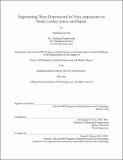Engineering Three Dimensional In Vitro Approaches to Study Cardiac Injury and Repair
Author(s)
Das, Shoshana Lea
DownloadThesis PDF (5.007Mb)
Advisor
Chen, Christopher S.
Terms of use
Metadata
Show full item recordAbstract
Each year, over one million people in the United States have a myocardial infarction (MI). After an infarct, the affected region undergoes massive cell death and a pathological fibrotic response. As cardiomyocytes (CMs) do not regenerate, the CM content is predominately replaced by activated cardiac fibroblasts (CFs). This modifies the regional mechanical and electrical properties, which increases the risk for arrythmias and heart failure in heart attack survivors. Despite the high incidence of MI, current treatments to mitigate the associated morbidity are limited, and the development of new treatments is impeded by expensive, low-throughput, in vivo studies that poorly predict clinical success.
The goal of this dissertation is to develop 3D engineered tissue systems and technologies to study cardiac injury and healing responses. The presented work develops a series of in vitro models that recapitulate the focal fibrosis created by MI and develops tools to functionally characterize engineered heart tissue (EHT) models after injury.
First, we create a 3D biomimetic model using human induced pluripotent stem cell (iPSC)-derived CMs and primary human CFs. Using a high-power, pulsed laser, we locally injure our EHT model to reproduce the regional cell death and loss of electrical and mechanical function seen in focal fibrosis of infarcted myocardium. We then demonstrate the capacity of this model to capture cardiac remodeling and the compensatory response of the surrounding tissue after injury. Second, we adapt a genetically-encoded voltage sensor, called Archon1, to enable the study of electrical activity of individual CMs within EHTs. We use this sensor to take high fidelity action potential measurements in iPSC-derived CMs and EHTs. Finally, as myocardium is highly aligned tissue, we explore the role of extracellular matrix (ECM) alignment on injury response. We study the behavior of fibroblasts in engineered anisotropic and isotropic tissues after injury. Our results indicate that the alignment of ECM directs provisional matrix assembly, a key healing response process.
In summary, this work demonstrates the development and utility of engineered tissue systems to study cardiac injury response. Such systems can be used to better understand injury responses and probe new therapies to improve recovery.
Date issued
2022-05Department
Harvard-MIT Program in Health Sciences and TechnologyPublisher
Massachusetts Institute of Technology